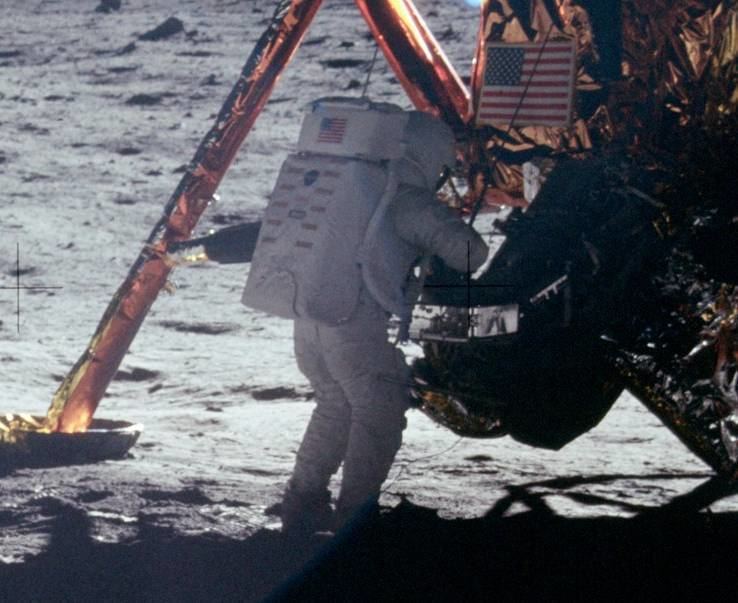The year 1969 in science and technology involved some significant events, listed below.
Astronomy and space exploration
January 15 – The Soviet Union launches Soyuz 5.
March 3 – Apollo program: NASA launches Apollo 9 to test the lunar module.
March 13 – Apollo program: Apollo 9 returns safely to Earth after testing the Lunar Module.
May 16 – Venera program: Venera 5, a Soviet spaceprobe, lands on Venus.
May 17 – Venera program: Soviet Venera 6 begins to descend into Venus', atmosphere sending back atmospheric data before being crushed by pressure.
May 18 – Apollo program: Apollo 10 launches.
May 22 – Apollo program: Apollo 10's lunar module flies within 15,400 m of the Moon's surface.
May 26 – Apollo program: Apollo 10 returns to Earth after a successful eight-day test of all the components needed for the upcoming first manned Moon landing.
July 20 – Apollo program: The human race, represented by Neil Armstrong and Buzz Aldrin, lands on the Moon. Apollo 11 lifted off for the Moon on July 16 and returned safely on July 24.
August 5 – Mariner program: Mariner 7 makes its closest fly-by of Mars (3,524 kilometers).
September 20 – Comet 67P/Churyumov–Gerasimenko is identified by Soviet astronomers Klim Churyumov and Svetlana Gerasimenko.
November 14 – Apollo program: NASA launches Apollo 12, the second manned mission to the surface of the Moon (landed on the Moon on November 19).
November 19 – Apollo program: Apollo 12 astronauts Charles Conrad and Alan Bean land at Oceanus Procellarum ("Ocean of Storms") and become the third and fourth humans to walk on the Moon.
Thomas D. Brock and Hudson Freeze of Indiana University publish their findings on hyperthermophilic bacteria, most notably Thermus aquaticus, a thermophilic bacterium species living at a temperature of 60-80°C in a hot spring at Yellowstone National Park. T. aquaticus (Taq) later becomes a standard source of enzymes able to withstand higher temperatures than those from E. Coli and is significant in the history of polymerase chain reaction.
Last Przewalski's Horse sighted in the wild, in Mongolia.
Dorothy Hodgkin and colleagues at the University of Oxford determine the structure of insulin.
April 7 – RFC 1, the first Request for Comments document from the Internet Engineering Task Force, is published.
October 29 – The first ARPANET message is sent, between computers at the University of California, Los Angeles (UCLA) and Stanford Research Institute.
November 21 – The first permanent ARPANET link is established, between Interface Message Processors at UCLA and Stanford.
The laser printer is invented at Xerox by Gary Starkweather.
April 4 – Surgeons Denton Cooley and Domingo Liotta implant the first temporary artificial heart.
Reported as being the year the first strain of the AIDS virus (HIV) migrates to the United States via Haiti.
The condition diffuse panbronchiolitis is named, in Japan.
International adoption of the diagnostic term 'Sudden infant death syndrome'.
Late January – Eugene, Oregon, has a record snowfall of 3 feet in 3 days: a pineapple express moves into the region with a shot of cold air, followed by some snow showers.
Herbert Saffir and Bob Simpson develop the Saffir-Simpson Hurricane Scale.
John Ostrom publishes his findings on the dinosaur Deinonychus, describing it as being a small, agile species closely related to the birds.
Yoichiro Nambu and Leonard Susskind make the first presentations of string theory.
Spain withdraws from CERN.
Nobel Prizes
Physics – Murray Gell-Mann
Chemistry – Derek Harold Richard Barton, Odd Hassel
Medicine – Max Delbrück, Alfred D. Hershey, Salvador Luria
Turing Award – Marvin Minsky
October 7 – Karen L. Nyberg, American space engineer and astronaut.
December 16 – Adam Riess, American astrophysicist, Nobel laureate in Physics in 2011.
December 28 – Linus Torvalds, Finnish computer programmer.
Thomas Reardon, American computer programmer.
March 3 – Elizabeth Laird (born 1874), Canadian physicist.
May 14 – Walter Pitts (born 1923), American logician and cognitive psychologist.
June 24 – Willy Ley (born 1906), German American scientific populariser.
August 8 – Otmar von Verschuer (born 1896), German eugenicist.
August 17 – Otto Stern (born 1888), German physicist, Nobel laureate in Physics in 1943.
September 16 – Henry Fairfield Osborn, Jr. (born 1887), American conservationist.
September 24 – Warren Sturgis McCulloch (born 1898), American neurophysiologist and cybernetician.
October 21 – Wacław Sierpiński (born 1882), Polish mathematician.
November 12 – William F. Friedman (born 1891), Russian American cryptanalyst.
1969 in science Wikipedia (Text) CC BY-SA

